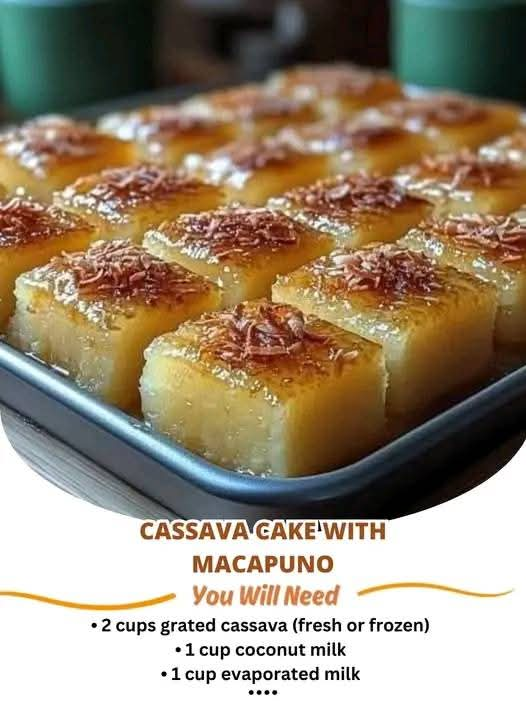Introduction
Cassava cake with macapuno is a beloved Filipino dessert known for its rich, creamy texture and sweet, tropical flavors. Made from grated cassava, coconut milk, and condensed milk, this dessert is a delightful combination of chewy and soft, with macapuno (sweetened coconut strings) adding an extra layer of sweetness and texture. Whether served at family gatherings, fiestas, or as an everyday treat, this cake is a crowd-pleaser that highlights the versatility of cassava in Filipino cuisine.
The addition of macapuno elevates the traditional cassava cake, giving it a more luxurious taste and mouthfeel. This dessert is not only delicious but also relatively easy to prepare, making it a favorite among home bakers. With its golden-brown top and custard-like consistency, cassava cake with macapuno is a dessert that satisfies both the eyes and the palate.
Ingredients
- 2 cups grated cassava (fresh or frozen)
- 1 cup coconut milk
- 1 cup evaporated milk
- 1 cup condensed milk
- 3/4 cup sugar
- 1/4 cup melted butter
- 2 eggs
Instructions
Preheat the oven to 350°F (175°C). In a large mixing bowl, combine the grated cassava, coconut milk, evaporated milk, condensed milk, sugar, melted butter, and eggs. Mix well until fully incorporated.
Pour the batter into a greased baking dish and bake for 45-50 minutes or until the top is set and slightly golden.
Remove from the oven and let it cool before slicing. For an extra touch, top with additional macapuno or a drizzle of condensed milk before serving.
Variations
For a richer flavor, some bakers add a layer of custard on top of the cassava cake. This is made by mixing egg yolks, condensed milk, and coconut milk, then pouring it over the partially baked cake before returning it to the oven.
Another variation includes adding cheese, either mixed into the batter or sprinkled on top, for a sweet and savory contrast.
Those who prefer a stronger coconut taste can replace part of the evaporated milk with additional coconut milk. Alternatively, ube (purple yam) can be incorporated into the batter for a vibrant color and unique flavor twist. Experimenting with different toppings, such as latik (coconut curds) or toasted coconut flakes, can also add depth to the dessert.
For a gluten-free or dairy-free version, substitute regular condensed milk with coconut condensed milk and use a plant-based butter alternative. This ensures the cake remains accessible to those with dietary restrictions while maintaining its delicious taste.
Tips
When using frozen grated cassava, make sure to thaw and drain excess liquid to prevent the cake from becoming too watery. Fresh cassava should be peeled and finely grated for the best texture. If the cassava is too coarse, the cake may turn out grainy.
To achieve a perfectly baked cassava cake, check for doneness by inserting a toothpick into the center. If it comes out clean, the cake is ready. #
Avoid overbaking, as this can make the cake dry. For a moister result, some bakers steam the cake instead of baking it.
For an even golden top, brush the cake with butter or coconut milk halfway through baking.
This enhances the color and adds a subtle sheen. Let the cake cool completely before slicing to ensure clean cuts and a firm texture.
How to Store
Cassava cake with macapuno can be stored at room temperature for up to two days if kept in an airtight container.
However, in warmer climates, it’s best to refrigerate it to prevent spoilage. The cake tends to firm up when chilled, but its flavor remains intact.
For longer storage, the cake can be refrigerated for up to five days. To maintain moisture, cover it with plastic wrap or place it in a sealed container.
Before serving leftover cake, gently reheat it in the microwave or oven to restore its soft texture.
If freezing, wrap individual slices tightly in plastic wrap and store them in a freezer-safe bag for up to a month.
Thaw in the refrigerator overnight and reheat before serving. Freezing may slightly alter the texture, but the cake will still taste delicious.
Conclusion
Cassava cake with macapuno is a delightful dessert that brings together the natural sweetness of cassava and the rich flavor of coconut. Its simplicity in preparation makes it an excellent choice for both novice and experienced bakers. Whether enjoyed warm or chilled, this cake is sure to be a hit at any gathering.
With its versatility and room for creativity, cassava cake can be adapted to suit different tastes and dietary needs. From adding custard layers to experimenting with toppings, there are countless ways to make this dessert uniquely yours. No matter how it’s prepared, cassava cake with macapuno remains a cherished treat in Filipino cuisine.
